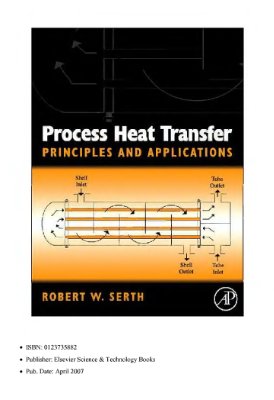Acаdemic Prеss, 2007. 770 p. ISBN:0123735882.
Process Heat Transfer Rules of Thumb investigates the design and implementation of industrial heat exchangers. It provides the background needed to understand and master the commercial software packages used by professional engineers for design and analysis of heat exchangers. This book focuses on the types of heat exchangers most widely used by industry, namely shell-and-tube exchangers (including condensers, reboilers and vaporizers), air-cooled heat exchangers and double-pipe (hairpin) exchangers. It provides a substantial introduction to the design of heat exchanger networks using pinch technology, the most efficient strategy used to achieve optimal recovery of heat in industrial processes.
Utilizes leading commercial software important to professional engineers designing heat exchangers.
Illustrates design procedures using complete step-by-step worked examples.
Provides details on how to develop an initial configuration for a heat exchanger and how to systematically modify it to obtain a final design.
Abundant example problems solved manually and with the integration of computer software.
Heat Conduction
Convective Heat Transfer
Heat Exchangers
Design of Double-Pipe Heat Exchangers
Design of Shell and Tube Heat Exchangers
The Delaware Method
The Stream Analysis Method
Heat Exchanger Networks
Boiling Heat Transfer
Reboilers
Condensers
Air-Cooled Heat Exchangers
Process Heat Transfer Rules of Thumb investigates the design and implementation of industrial heat exchangers. It provides the background needed to understand and master the commercial software packages used by professional engineers for design and analysis of heat exchangers. This book focuses on the types of heat exchangers most widely used by industry, namely shell-and-tube exchangers (including condensers, reboilers and vaporizers), air-cooled heat exchangers and double-pipe (hairpin) exchangers. It provides a substantial introduction to the design of heat exchanger networks using pinch technology, the most efficient strategy used to achieve optimal recovery of heat in industrial processes.
Utilizes leading commercial software important to professional engineers designing heat exchangers.
Illustrates design procedures using complete step-by-step worked examples.
Provides details on how to develop an initial configuration for a heat exchanger and how to systematically modify it to obtain a final design.
Abundant example problems solved manually and with the integration of computer software.
Heat Conduction
Convective Heat Transfer
Heat Exchangers
Design of Double-Pipe Heat Exchangers
Design of Shell and Tube Heat Exchangers
The Delaware Method
The Stream Analysis Method
Heat Exchanger Networks
Boiling Heat Transfer
Reboilers
Condensers
Air-Cooled Heat Exchangers

